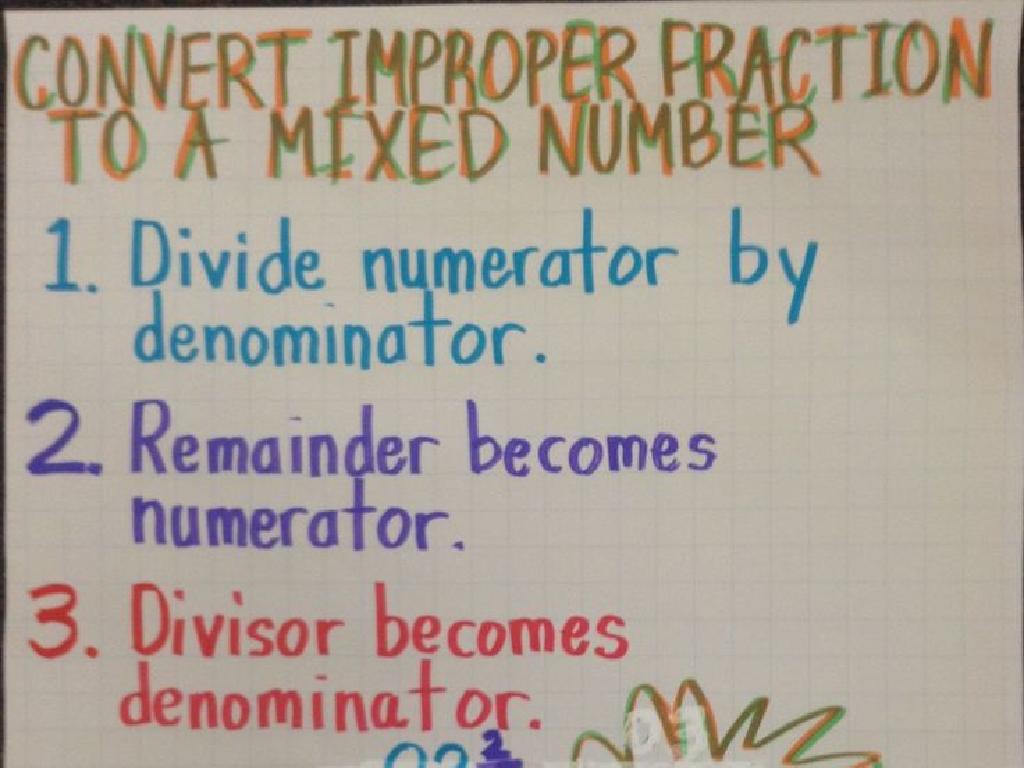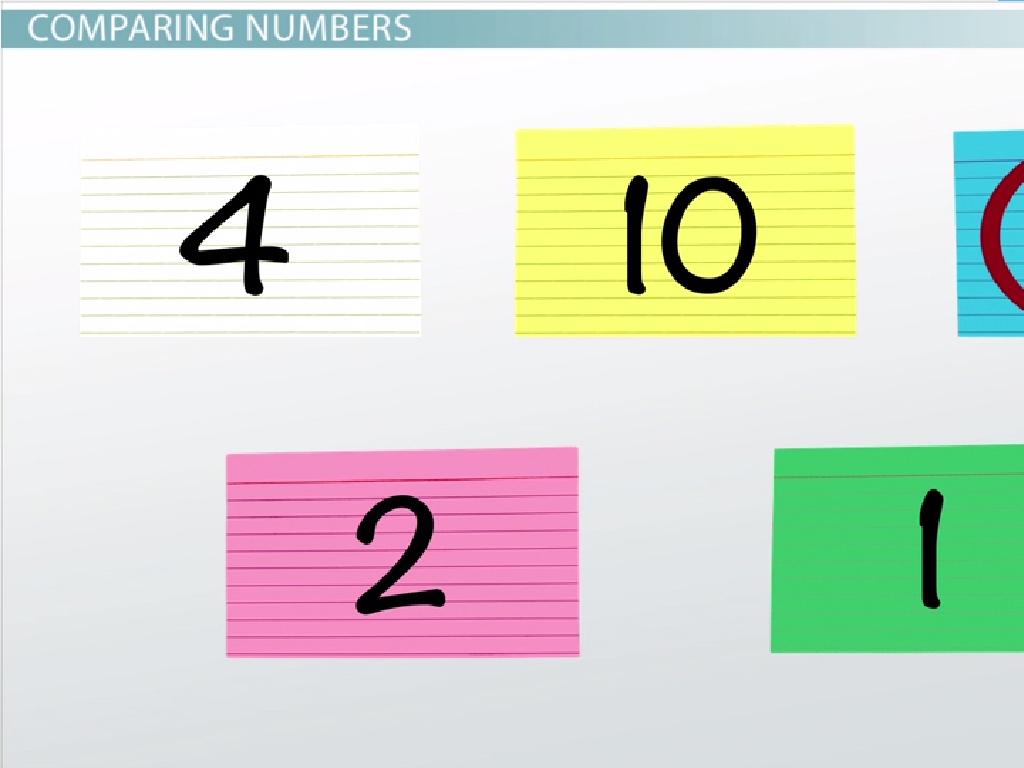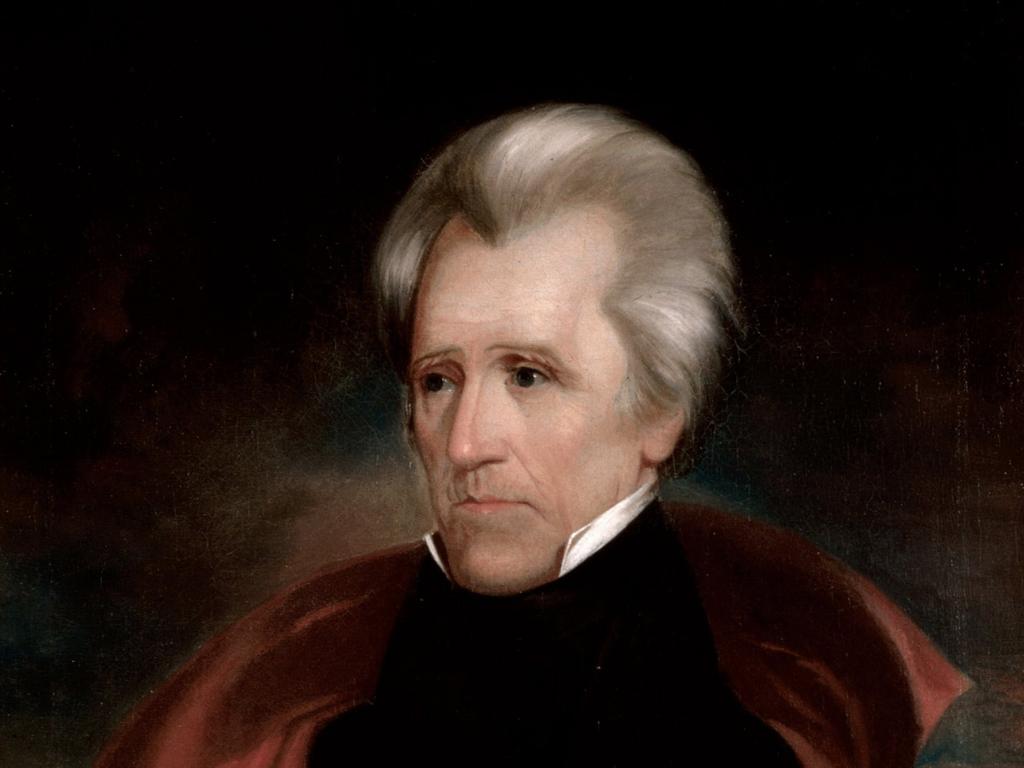Least Common Multiple
Subject: Math
Grade: Sixth grade
Topic: Number Theory
Please LOG IN to download the presentation. Access is available to registered users only.
View More Content
Exploring Least Common Multiples (LCM)
– Understanding number building blocks
– Numbers are made up of smaller ‘building blocks’ called factors.
– Key concept: Least Common Multiple
– LCM is the smallest number that is a multiple of two or more numbers.
– LCM’s role in math
– LCM helps in adding, subtracting fractions & solving problems with different units.
– LCM in real-life scenarios
– Use LCM to plan events or divide things into equal parts without leftovers.
|
Today’s lesson introduces the concept of Least Common Multiples, a fundamental aspect of number theory. Begin by discussing factors and how they combine to form numbers. Explain LCM as the smallest shared multiple of a set of numbers, which is crucial for various mathematical operations, especially in dealing with fractions. Highlight the importance of LCM in solving real-world problems, such as coordinating schedules or dividing resources evenly. Provide examples and encourage students to think of situations where they might need to find the LCM. This will help them understand the practicality and relevance of LCM in everyday life.
Understanding Multiples
– Define a multiple
– A multiple is a product of a number and an integer, e.g., 2 x 3 = 6
– Examples for 2, 3, and 5
– For 2: 4, 6, 8; for 3: 6, 9, 12; for 5: 10, 15, 20
– Multiples as ‘number families’
– Just as families have members, numbers have multiples
– Recognizing patterns in multiples
|
This slide introduces the concept of multiples, which are the building blocks for understanding least common multiples (LCM). Start by defining a multiple and ensure students grasp that it’s a result of multiplying a number by an integer. Use examples for the numbers 2, 3, and 5 to illustrate the concept clearly. Explain that multiples can be thought of as the ‘extended family’ of a number, which includes the number itself and all the products formed by multiplying it with integers. Highlight the pattern that emerges in the list of multiples for each number and encourage students to look for such patterns when identifying multiples. This will set a strong foundation for finding the LCM in subsequent lessons.
Discovering the Least Common Multiple (LCM)
– LCM: Smallest common multiple
– The LCM of two numbers is the smallest number that both can divide without a remainder.
– Understanding ‘least’ in LCM
– We focus on the ‘least’ or smallest multiple shared by the numbers.
– LCM in everyday life
– LCM helps in planning events to fit into different schedules without conflicts.
– Example: Scheduling events
– If two events occur every 4 and 6 days, LCM tells us they’ll coincide every 12 days.
|
The concept of Least Common Multiple (LCM) is crucial for understanding how to find the smallest number that two or more numbers can divide into evenly. It’s important to emphasize the ‘least’ aspect, as we’re interested in the smallest shared multiple, not just any common multiple. Relate LCM to real-life scenarios such as scheduling, where finding a common time slot for multiple events is essential. For example, if one event occurs every 4 days and another every 6 days, the LCM of 4 and 6 is 12, meaning both events will happen together every 12 days. This practical application helps students see the relevance of LCM in everyday life.
Methods to Find the Least Common Multiple (LCM)
– Listing Multiples Method
– List multiples of each number, then find the smallest common multiple.
– Prime Factorization Method
– Break numbers into prime factors, multiply the highest power of all primes.
– Using GCD for LCM
– Find GCD first, then LCM = (Product of numbers) / GCD.
|
This slide introduces three methods to find the Least Common Multiple, an important concept in number theory for sixth graders. The Listing Multiples Method involves writing out multiples of each number until the smallest common one is found. The Prime Factorization Method requires breaking down each number into its prime factors and then combining these factors, using the highest power of each prime. The third method uses the Greatest Common Divisor (GCD); after finding the GCD of the numbers, the LCM is calculated by dividing the product of the numbers by the GCD. Provide examples for each method to ensure students can apply them effectively. For instance, to find the LCM of 12 and 15, list the multiples, use prime factorization, or find the GCD (which is 3), then apply the formula LCM = (12 * 15) / 3 to get the LCM of 60.
Finding the Least Common Multiple (LCM)
– List down multiples of each number
– For 4 and 6: 4, 8, 12, 16, 20…; 6, 12, 18, 24…
– Spot the common multiples
– Look for numbers that appear in both lists
– Select the smallest common multiple
– The first number that’s the same on both lists is the LCM
– LCM is the shared multiple
|
This slide introduces the concept of finding the Least Common Multiple (LCM) using the listing multiples method. Start by writing down several multiples of each number. Then, guide students to identify which multiples are common to both lists. Emphasize that the LCM is the smallest number that appears in both lists. For example, when comparing multiples of 4 and 6, the number 12 is the first common multiple, making it the LCM. Encourage students to practice with different sets of numbers to become comfortable with the process. This method helps reinforce multiplication skills and introduces them to the concept of commonality in number theory.
Finding LCM Using Prime Factorization
– Break numbers into prime factors
– For 12 and 18, prime factors are 2^2 * 3 and 2 * 3^2
– Multiply factors by greatest occurrence
– Use 2^2 (from 12) and 3^2 (from 18)
– The product is the LCM
– LCM of 12 and 18 is 2^2 * 3^2 = 36
|
This slide introduces the prime factorization method for finding the least common multiple (LCM) of two numbers. Begin by explaining how to break down numbers into their prime factors. Then, instruct students to identify each unique factor and multiply it by the greatest number of times it appears in any of the numbers. The resulting product is the LCM. Use examples like 12 (2^2 * 3) and 18 (2 * 3^2) to illustrate the process. Emphasize that the highest powers of prime factors are used to ensure all original numbers can be divided by the LCM without a remainder. This method helps students understand the fundamental building blocks of numbers and the concept of multiples.
LCM Using GCD
– Relationship between GCD and LCM
– GCD, or Greatest Common Divisor, is linked to LCM
– LCM formula using GCD
– Use LCM(a, b) = (a × b) / GCD(a, b) to find LCM
– Step 1: Calculate GCD
– Find the largest number that divides both a and b
– Step 2: Find the LCM
– After GCD, divide the product of a and b by GCD to get LCM
|
This slide introduces the concept of finding the Least Common Multiple (LCM) using the Greatest Common Divisor (GCD). It’s crucial to explain the inverse relationship between GCD and LCM, where GCD is the highest number that divides two numbers without a remainder, and LCM is the smallest number that both numbers can divide into without a remainder. The formula provided is a practical tool for finding the LCM once the GCD is known. Start by guiding students through the process of finding the GCD of two numbers, then use the product of the numbers divided by their GCD to find the LCM. Provide examples and practice problems to help solidify their understanding.
LCM Practice Problems
– Find LCM of 12 and 18
– Use prime factorization or listing multiples
– LCM for 14 and 20
– Try both methods, see which is easier
– Choose your preferred method
– Challenge: LCM of 24, 36, 48
– Apply your skills to find a common multiple
|
This slide presents practice problems for finding the Least Common Multiple (LCM). Start with simpler pairs like 12 and 18 to ensure understanding of the concept. Encourage students to use different methods such as listing multiples or prime factorization to find the LCM. For 14 and 20, ask students to compare methods and decide which they prefer, fostering critical thinking. The challenge problem with 24, 36, and 48 will test their grasp of the concept with a more complex set of numbers. During the next class, review these problems, discuss different methods used, and ensure that students can explain their reasoning.
Class Activity: LCM Scavenger Hunt
– Pair up for LCM item hunt
– Find items with a common LCM
– Present and explain your LCM findings
– Reflect on LCM’s role in the hunt
– Did LCM make finding items easier?
|
In this engaging class activity, students will work in pairs to search for items around the classroom or school that have quantities with a common Least Common Multiple (LCM). This hands-on approach helps students apply their understanding of LCM in a practical context. After the hunt, each pair will present their items and explain how they determined the LCM, reinforcing their comprehension through teaching. Finally, students will reflect on how the concept of LCM aided them in the scavenger hunt, solidifying the real-world application of LCM. For the teacher: Prepare a list of potential items and their quantities in advance to guide students if necessary. Consider having different LCM targets for each group to diversify the learning experience.
Wrapping Up: Least Common Multiple
– Recap: What is LCM?
– The smallest number two or more numbers can divide into.
– LCM’s role in problem-solving
– LCM helps us combine different rhythms, schedules, or quantities efficiently.
– Homework: LCM practice worksheet
– Observe LCM in daily life
– Look for patterns in bus schedules or baking batches.
|
As we conclude today’s lesson, remind students of the definition of the Least Common Multiple (LCM) and its significance in various problem-solving scenarios, such as finding common denominators or coordinating events. For homework, students will reinforce their understanding by completing a worksheet with LCM problems. Encourage them to not only practice these skills but also to be observant of how LCM appears in everyday life, such as in public transportation schedules or while cooking. This real-world connection will help solidify the concept and its utility.



/convergence_divergence_history.png)

